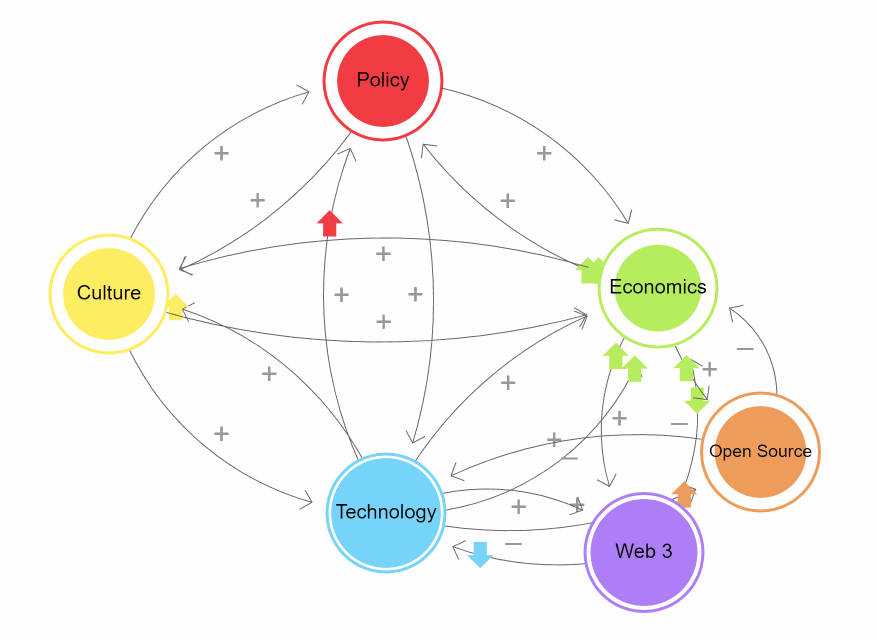This is a critical point: the products we create should not aim to make people "more free" - that way lies false marketing campaigns and disappointment. Our products should be conscious of, and communicate clearly, how they constrain the people who use them. In doing so, they create the environment for people to become aware of the trade-offs they themselves are making, which is the only kind of freedom we can trust to generate sustainable value.
In the previous guild session, we finished by examining how new playful primitives, like the Loot contracts Austin worked with, are calling into question the boundaries between "in-game" and "real-life" economies. We phrase that very carefully, because questioning a boundary is not the same as breaking it down, a point made with Chesterton's fence in Module 4.
Infinite players play with the boundaries, they don't just burn them down out of anger or frustration. We'd like to suggest that primitives like NFTs make previously solid boundaries permeable. That is, every contract has an Application Binary Interface (ABI) which specifies exactly what it does and what information you are likely to get back when calling any of its routes. Interfaces are not about inclusion and exclusion, they are about how we communicate across the common boundary of two distinct yet co-extensive bodies.
In addition, the storage of each contract is public and may be inspected by anyone. These two facts: public interfaces and open storage imply a whole new design space for interoperability which is not just about moving assets between games, but perhaps means new ways of crafting communication between metaverses so that we can truly realise the pluriverse. This is, after all, what the word "metaphor" avtually means: to carry meaning across. Just don't limit yourself to thinking that assets are the only meaningful things in either games or "real" life.
Piecing the Puzzle Together¶Smart contracts and playful primitives are a good step forward, but the game industry is a huge interconnected ecosystem of agents that includes game developers, content creators, platforms, publishers, ad providers, and game engines, just to name a few. If we try to replace one part of the puzzle, the part that replaces it will be exactly the same shape.
There are numerous examples of this: one instance is when app stores were seen to be an equalizer for game development, but through the years have reconsolidated around who controls discoverability. Another is how game engines like Unity were supposed to democratize game development, but the drive for growth and current market conditions have led them to optimize around ads.

This image is taken from the work of Nicky Case, who helpfully reminds us that change usually comes from Evolution, Not Revolution.
Even though evolution revolves slowly, the cultural aspects of it can only begin if you and I start them. And we are not alone: Web 3 itself is an evolution of a movement that started with the Internet, and is carried on by many players in the distributed web.

We must always remember that, even though what we're working on doesn't always seem to move the needle now, each of these systems are themselves comprised of smaller subsystems. By focusing on the ones that we can currently affect, we can cascade these small changes into a mass movement.
Opening Pluriverses¶Reflect for a moment on the game of forking documents presented in The Declaration of Interdependence, or the way that the pluriverse plays with the concept of a Terms of Use Agreement.
Such networked knowledge artifacts, or interconnected sites of meaning, allow us to explore more deeply the idea of permeability and "surfaces of continuity". When we really reflect on how permeability is enacted, how information may be communicated continuously across the boundary between coextensive but distinct bodies, we notice that ABIs and the protocols on which they rely actually create "hard diegetic boundaries", or "autonomous worls". Such formal boundaries and encoded rules don't sound very permeable. However, just as building "trustless" protocols enables us to explore new trust spaces between one another, implementing interobjective realities may perhaps enable new subjective explorations of play. There is a sequence at work here - first trustless protocol, then new kinds of trust spaces; first hard diegetic boundary and autonomous world, then new possibilities for meaningful (therefore subjective) games - but it is critical to note that creating clear boundaries is not an end in itself: it is actually the very thing which enables more information to pass between more regularly.
Of course, the declaration and the pluriverse don't look much like traditional games, though many which do - like Dark Forest - exhibit similarly bounded permeability.
The core point about the freedom to play with boundaries is that truly skillful players - those magisters of the infinite arts - know that the core skill is humility. As Nicky Case writes:
Humility is the knowledge we don't have that much knowledge. We're all too stupid to completely overhaul a complex political/economic/cultural system. We can't build a world from scratch, so we have to use what's already there. We can't find a silver bullet, so we've got to evolve all the parts simultaneously.
For this week, we'll be drawing 🟠 circles and ↗ arrows.
Below is Nicky Case's diagram of interconnected systems. We've tried to identify Web 3 concepts and technologies that could be part of each system and have added them beside their respective nodes.
Where would your product fit in this diagram? Consider which systems your product affects and which ones affect it back.
Don't hesitate to add or remove nodes and arrows. This is just a model to help you think through systems, and there is no correct answer.
Click on the
🔀 REMIXOnce done, please share your diagrams on Slack. It will be useful learning also for your peers! 🙌